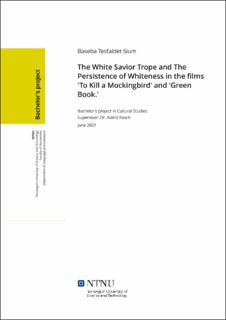| dc.contributor.advisor | Rasch, Astrid | |
| dc.contributor.author | Sium, Baseba Tesfaldet | |
| dc.date.accessioned | 2021-09-24T18:37:20Z | |
| dc.date.available | 2021-09-24T18:37:20Z | |
| dc.date.issued | 2021 | |
| dc.identifier | no.ntnu:inspera:77725432:23988733 | |
| dc.identifier.uri | https://hdl.handle.net/11250/2782034 | |
| dc.description.abstract | Filmer har en tendens til å gjenspeile samfunnet vårt og er viktig kilder for hvordan vi forholder oss til andre. Derfor er det viktig å undersøke hvordan disse filmene skildrer rase og rasisme i sin samtid. Noen forskere hevder at hvithet og dets overlegenhet ofte blir skildret gjennom filmer, spesielt filmer som inneholder ‘hvite frelser’ narrativ. Denne oppgaven vil analysere hvordan to filmer, ‘To Kill a Mockingbird’ og ‘Green Book’, utgitt i 1962 og 2018, representerer rase relasjonen i sin samtid og hvordan disse filmene inneholder ‘hvite frelser’ narrative. Videre har denne studien til hensikt å svare på hvordan hvite frelser narrative opprettholder hvitheten som en norm, og hva er konsekvensene av dette. Ved å bruke de fem prinsippene i kritisk raseteori, vil denne studien undersøke hvordan kulturformidlere som filmer skildrer rase relasjoner, rasisme og hvordan de opprettholder hvithet. | |
| dc.description.abstract | Films tend to reflect our society and are a highly influential part of our attitudes toward
others. Therefore, it is crucial to examine how these films portray race and racism in their
contemporary era. Some scholars argue that whiteness and its superiority are often portrayed
through films, especially films that contain the white savior trope. This thesis will analyze
how two films, To Kill a Mockingbird and Green Book, releases in 1962 and 2018, represent
the racial tension of their time and how they contain the white savior trope. Furthermore, this
study intends to answer how the white savior trope preserves whiteness as a norm and what
are the consequences of this. Utilizing the five tenets of Critical Race Theory, this study will
examine how cultural mediators like films portray race relations, racism and preserves
whiteness. | |
| dc.language | eng | |
| dc.publisher | NTNU | |
| dc.title | The White Savior Trope and The Persistence of Whiteness in the films 'To Kill a Mockingbird' and 'Green
Book.' | |
| dc.type | Bachelor thesis | |
